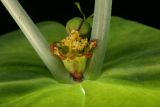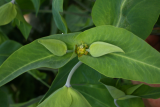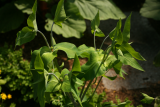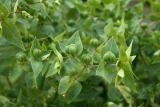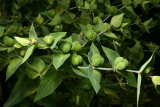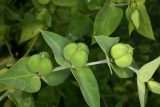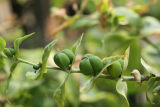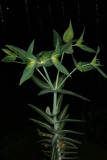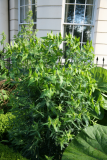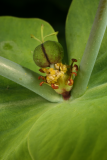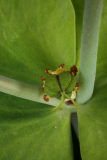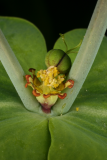Additional notes (click to expand)
Commemorative
The genus is named for Euphorbus (fl. circa 10 BC – AD 20), the Greek physician to the Berber king Juba II (c. 50 BC – AD 23) of Numidia, a country which once existed within modern Tunisia and Algeria. He was the brother of Antonio Musa (vide Musa), physician to Caesar Augustus. The king married Cleopatra Selene, the daughter of Mark Anthony and Cleopatra, and later, Glaphyra, the widow of the son of Herod the Great. The king was interested in plants and, according to Pliny the
Elder (Pliny, AD 79), gave it its name in 12 BC. In the 16th century it was known as Tithymalus, but
Linnaeus restored the name Euphorbia in 1753. One story is that Euphorbus cured King Juba from
a stomach condition with a Euphorbia. The other is that the plant was discovered by the king in
the Atlas mountains of Morocco and that, as Euphorbus was a fat man and the plant was fleshy, he thought it an apt name as ‘euphorbus’ in Greek means ‘eu = good’ and ‘phorbe = fodder’. Juba is remembered elsewhere, for he gives his name to the capital of the new country of South Sudan. Euphorbia regis-jubae, discovered on an expedition to the Canary Islands, sponsored by King Juba, also commemorates him.
Oakeley, Dr. Henry. (2012). Doctors in the Medicinal Garden. Plants named after physicians. Royal College of Physicians.
link
Medicinal
Culpeper: “Esulae, majoris minoris, spurge the greater, the lesser, they are both (taken inwardly), too violent for a vulgar use; outwardly in ointments they cleanse the skin, and take away sun-burning.” [This may be Euphorbia peplus…]
Culpeper, Nicholas. (1650). A Physical Directory . London, Peter Cole.
Nomenclature
CAPE SPURGE; MYRTLE SPURGE; MOLE PLANT; ESULAE.
Other use
Fuels: potential as petroleum substitute/alcohol.
Germplasm Resources Information Network (GRIN) at www.ars-grin.gov/cgi-bin/npgs/html/tax_search.pl
Sap once used by beggars to produce ulcers in order to gain pity.
Grieve, Mrs M. (1931). A Modern Herbal, Penguin. Leyel, Mrs CF
Toxicity
Vertebrate poisons: mammals.
Germplasm Resources Information Network (GRIN) at www.ars-grin.gov/cgi-bin/npgs/html/tax_search.pl
Not the source of the edible capers – for, like many plants, it is very toxic (especially the seeds), and should not be taken internally. Like all spurges, the white latex is irritant and has been used on warts and corns. On normal skin it causes redness and, with repeated use, ulceration. It is said to repel moles (the animal sort), but proof is lacking.
Oakeley, Dr. H. F. (2013). The Gardens of the Pharmacopoeia Londinensis.
Toxic due to highly irritant saponins in sap (‘Latex’)
Professor Anthony Dayan, 2022
Geographical distribution
- Asia-Temperate, China
- Europe, Southeastern Europe, Greece
- Europe, Southeastern Europe, Italy
- Europe, Southwestern Europe, France
Euphorbia lathyris L.
Family: EUPHORBIACEAEGenus: Euphorbia
Species: lathyris L.
Common names: Caper Spurge
Pharmacopoeia Londinensis name: Esula
Distribution summary: China, S.Europe
Habit: Biennial
Hardiness: H5 - Hardy; cold winter
Habitat: Woods, banks, ditches, mountains
Garden status: Currently grown
Garden location: Poisons garden (PETO), Pharmacopoeia Londinensis 1618 'Roots' (HSE 2)
Flowering months: May, June
Reason for growing: Commemorative, medicinal, toxic
 (1).jpg)
